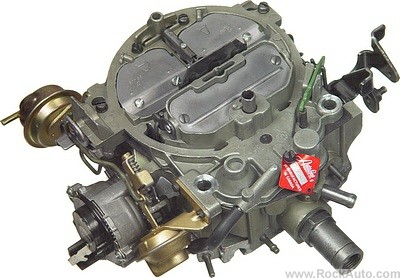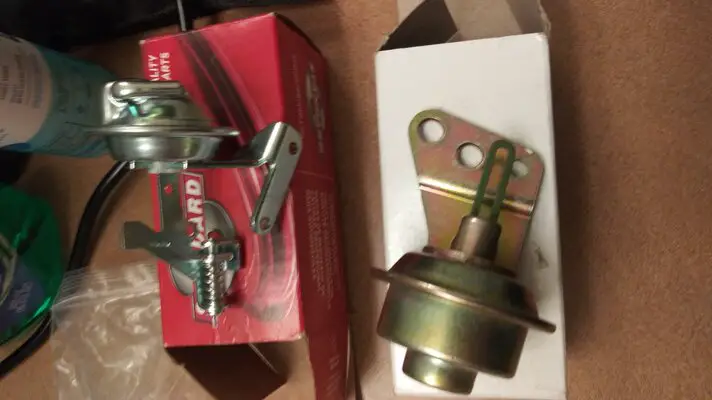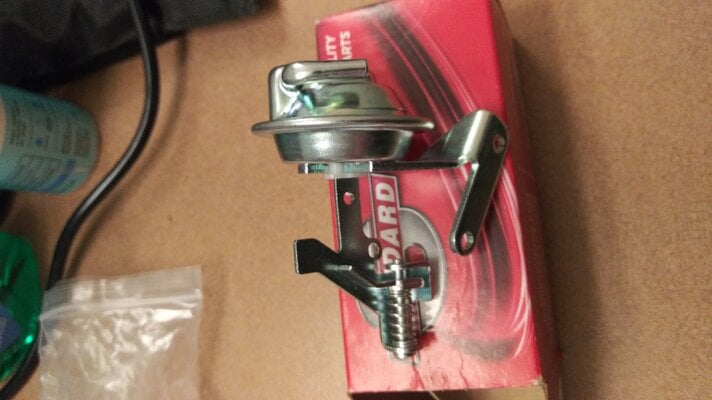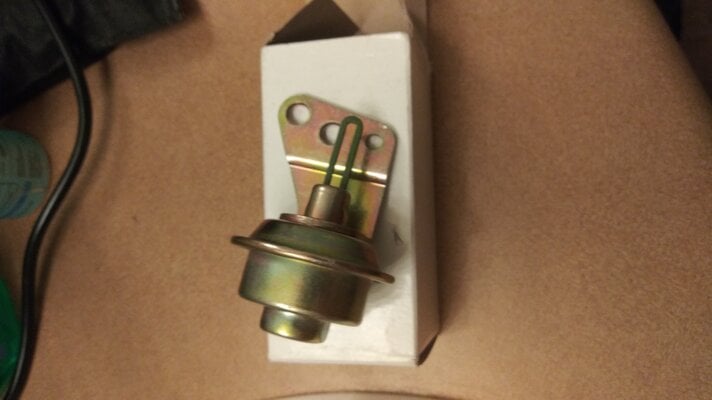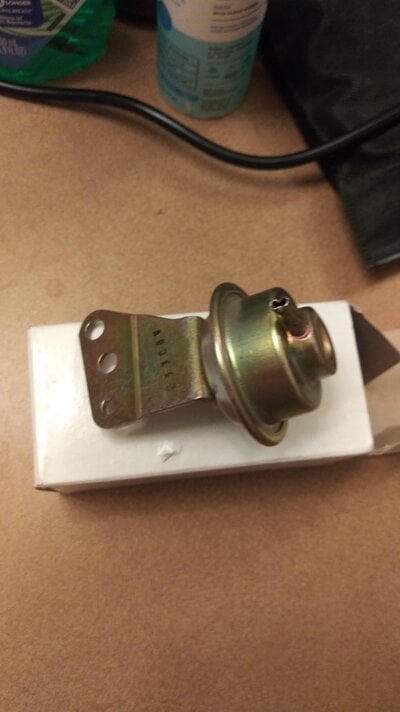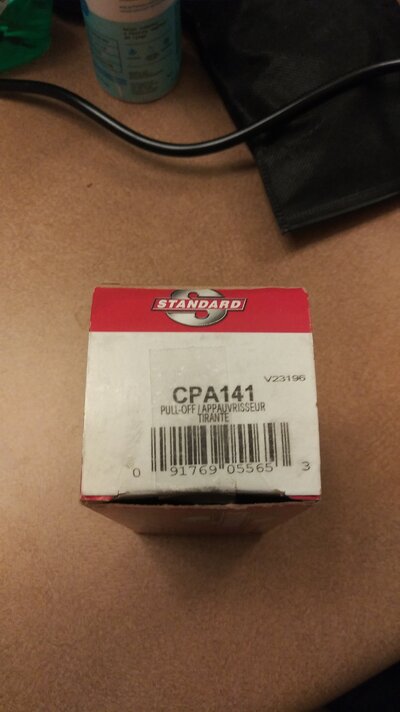Can't speak for other makes/models, but after a complete restoration campaign on my 85 442 carb, I can attest that Olds loved the rear vacuum break (RVB) on its CCC Quadrajet carbs. And I never gave the rear vacuum break much thought until then.
The factory service manuals don't explain the function and purpose of this animal very well. And that got me to thinking maybe there's something that some of the Q-jet gurus may be able to explain better than what I know about it. My searches ran empty. But I did find that some people were confusing the RVB on these carbs with carbs of yesteryear in saying they were part of the secondary circuit. Which it is incorrect for the Olds CCC Q-jet carbs. Thusly, I'm betting there's not much understanding of what this thing hanging off the back of the carb should do.
In the pic below, the RVB is on the left, and a timed vacuum hose would hook up to it. So let me attempt an explanation:

We already should know what the primary vacuum break, or choke pulloff is used for. It is dual purpose. It keeps the secondary air valves from slamming open immediately when you stomp the gas pedal, as well as cracking open the choke plate every so slightly on a cold start up. Failure of the choke pulloff lets you know right away at first startup. Usually it's the diaphragm that fails. Failure keeps the choke plate closed during cold start up and the result is rough running and black clouds of smoke from the exhaust (over-rich condition).
Enter the CCC controlled rear vacuum break. Initially when the car cranks up for the first time, the ECM grounds out terminal "6", and the rear vacuum break coil on the ILC/RVB/EGR solenoid pack (found above driver's side rear valve cover area) energizes to cut off vacuum supply to the rear vacuum break to keep it from operating (Fail state is vacuum supplied to the RVB). After 30 seconds, the ECM de-energizes the EGR solenoid which ALLOWS vacuum to the rear vacuum break to retract the plunger. This pulls the choke plate open slightly FURTHER than the primary choke pulloff does. I think it's like 41 degrees on the 85 442.
If the choke coil releases enough for the weight to open the choke plate further than 41 degrees within the 30 seconds, the rear vacuum break actuation does nothing for the car, since the choke plate is already open at or past the degrees the RVB will pull it open, so no effect. This obviously happens in warmer or cool weather, such as in the fall, etc.
During VERY COLD conditions, like freezing and negative numbers cold, the choke coil wraps up tighter so when you first start the car, the choke pulloff works harder to crack open the choke. If in good shape, it will do it, but it's also obvious that it's going to try and keep the choke plate closed longer, so the richer mixture in the ultra cold will need more air to keep from loading up. This is where the RVB takes over after 30 seconds to pull open that choke plate just a bit further to help prevent the loading up in the extreme weather conditions. So as soon as you step on the gas to move the car, the RVB plunger pulled in allows for better cold driveability until the car is completely warmed up.
This is why I have said that the RVB, if missing or vacuum line is plugged, is not a big deal for MOST climates outside of extreme cold. It would be rare to actually need it for most of us. Some carbs don't even come with an RVB, but mostly those have electric chokes as well, so they will heat up anyway. But there are adjustments to the linkage, so if those are out of whack it COULD affect your primary choke pulloff. So don't just discount it out of hand.
The RVB is quite a complex setup that's ECM controlled as compared to the single, limited function it serves. But the engineers deemed it important, so there it is.
If anyone didn't pick up what I was layin' down, feel free to ask. I'll do my best to answer the questions about it. I'm not familiar with other makes/models, but I would assume if there's one there, it would function similarly, just maybe in a different way.
Here's a picture of one of them thar solenoids (for 1984 Y and 84-85 VIN 9). VIN Y and 9 for roller cam engines 85-up is p/n 1997126. (1985 442 is the only flat tappet cam for 1985 307.)

The factory service manuals don't explain the function and purpose of this animal very well. And that got me to thinking maybe there's something that some of the Q-jet gurus may be able to explain better than what I know about it. My searches ran empty. But I did find that some people were confusing the RVB on these carbs with carbs of yesteryear in saying they were part of the secondary circuit. Which it is incorrect for the Olds CCC Q-jet carbs. Thusly, I'm betting there's not much understanding of what this thing hanging off the back of the carb should do.
In the pic below, the RVB is on the left, and a timed vacuum hose would hook up to it. So let me attempt an explanation:

We already should know what the primary vacuum break, or choke pulloff is used for. It is dual purpose. It keeps the secondary air valves from slamming open immediately when you stomp the gas pedal, as well as cracking open the choke plate every so slightly on a cold start up. Failure of the choke pulloff lets you know right away at first startup. Usually it's the diaphragm that fails. Failure keeps the choke plate closed during cold start up and the result is rough running and black clouds of smoke from the exhaust (over-rich condition).
Enter the CCC controlled rear vacuum break. Initially when the car cranks up for the first time, the ECM grounds out terminal "6", and the rear vacuum break coil on the ILC/RVB/EGR solenoid pack (found above driver's side rear valve cover area) energizes to cut off vacuum supply to the rear vacuum break to keep it from operating (Fail state is vacuum supplied to the RVB). After 30 seconds, the ECM de-energizes the EGR solenoid which ALLOWS vacuum to the rear vacuum break to retract the plunger. This pulls the choke plate open slightly FURTHER than the primary choke pulloff does. I think it's like 41 degrees on the 85 442.
If the choke coil releases enough for the weight to open the choke plate further than 41 degrees within the 30 seconds, the rear vacuum break actuation does nothing for the car, since the choke plate is already open at or past the degrees the RVB will pull it open, so no effect. This obviously happens in warmer or cool weather, such as in the fall, etc.
During VERY COLD conditions, like freezing and negative numbers cold, the choke coil wraps up tighter so when you first start the car, the choke pulloff works harder to crack open the choke. If in good shape, it will do it, but it's also obvious that it's going to try and keep the choke plate closed longer, so the richer mixture in the ultra cold will need more air to keep from loading up. This is where the RVB takes over after 30 seconds to pull open that choke plate just a bit further to help prevent the loading up in the extreme weather conditions. So as soon as you step on the gas to move the car, the RVB plunger pulled in allows for better cold driveability until the car is completely warmed up.
This is why I have said that the RVB, if missing or vacuum line is plugged, is not a big deal for MOST climates outside of extreme cold. It would be rare to actually need it for most of us. Some carbs don't even come with an RVB, but mostly those have electric chokes as well, so they will heat up anyway. But there are adjustments to the linkage, so if those are out of whack it COULD affect your primary choke pulloff. So don't just discount it out of hand.
The RVB is quite a complex setup that's ECM controlled as compared to the single, limited function it serves. But the engineers deemed it important, so there it is.
If anyone didn't pick up what I was layin' down, feel free to ask. I'll do my best to answer the questions about it. I'm not familiar with other makes/models, but I would assume if there's one there, it would function similarly, just maybe in a different way.
Here's a picture of one of them thar solenoids (for 1984 Y and 84-85 VIN 9). VIN Y and 9 for roller cam engines 85-up is p/n 1997126. (1985 442 is the only flat tappet cam for 1985 307.)




